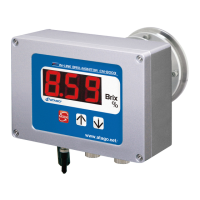8
2. Refractive Index and Brix(%)
The In-line Brix-Monitor is a refractometer that detects the Refractive Index of a sample and
outputs the Brix(%) value on the display.
The instrument can also transmit measured data to external devices via 4 to 20mA or
RS-232C.
(1) What is refractometer?
When a straw is placed into a glass filled with water, the straw appears to bend. When a
straw is placed into a glass filled with sugar water, the straw appears to bend much more
sharply than in the case of water alone. This phenomenon is known as the refraction of
light. The refractometer is an instrument that measures the Refractive Index by utilizing
this principle (the Refractive Index increases in proportion to the concentration of the
solution), and was developed by Dr. Ernst Abbe at the end of the 19th century.
(2) What is the Refractive Index?
If the Refractive Index of air under atmospheric pressure is
1, then when light enters mediumχ, the ratio of the sine of
the incident angleαmeasured against the phase boundary to
the sine of the refracting angleβis called the Refractive
Index of the medium χ.
The Refractive Index varies with the wavelength of light and
temperature and is represented as follows:
For example, Refractive Index of water at 20˚C under the D-line is:
= 1.33299 (Generally expressed as nD = 1.33299.)
m The Refractive Index is based upon the supposition that the Refractive Index in a
vacuum is 1 and is called the absolute Refractive Index. Generally, however, this index
is seldom used.
(3) Brix(%) scale
The instrument is programmed with the Brix(%) scale, based on the Refractive Index of
water (nD = 1.33299) as the reference (0%). The Brix(%) scale represents the weight of
sucrose expressed by percentage (sucrose weight in grams contained in 100 grams of
sucrose solution).
Therefore, this scale corresponds with the sucrose concentration. However, most
samples are comprised of ingredients other than sugar. The total concentration of these
ingredients is represented by the Brix(%), so this makes the Brix(%) scale a practical tool
for measuring concentrations.
m The Brix(%) scale is recommended by ICUMSA (International Committee of Uniform
Method of Sugar Analysis) and is expressed in % mas (Sucrose) in international units
(SI unit).
C The relationship between Brix(%) and the Refractive Index (nD) is outlined on
page 40.
(4) Temperature correction
The Refractive Index of a substance varies with temperature. Thus, when using a refractometer
to measure the Refractive Index of a liquid, the measurement value will vary with the sample
temperature.
The instrument always detects the prism temperature. The value of the measurement is
automatically corrected for temperature by a built-in processor, so that the displayed value is
equal to the value measured at 20˚C (provided that the sample temperature is within the range of
5 to 100˚C).
n : Represents the Refractive Index
t : Temperature (˚C)
D : D-line of natrium (589nm)
Air
Medium χ
n=1
α
β
nχ=
sin α
sin β

